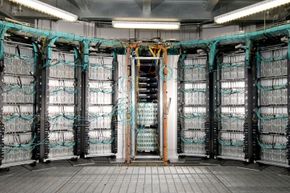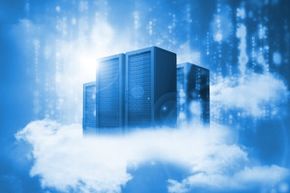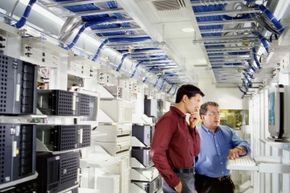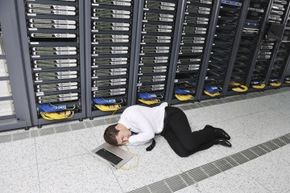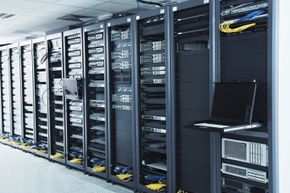When we think of data centers, many of us envision huge warehouses full of racks of servers, blinking and humming away, wires running to and fro. And in some cases we'd be right. But they come in all shapes, sizes and configurations. They range from a few servers in a room to huge standalone structures measuring hundreds of thousands of square feet with tens of thousands of servers and other accompanying hardware. Their sizes and the types of equipment they contain vary depending upon the needs of the entity or entities they are supporting.
There are various types including private cloud providers like the colos, public cloud providers like Amazon and Google, companies' private data centers and government data centers like those of the NSA or various scientific research facilities.
They are not staffed like offices with one person per computer, but with a smaller number of people monitoring large numbers of computers and networking devices, as well as power, cooling and other necessary building facilities. Some are so big that employees get around on scooters or bicycles. The floors have to hold more weight than a typical office building because the equipment can get heavy. They also have to have high ceilings to accommodate things like tall racks, raised floors and ceiling-hung cabling, among other things.
Many companies with heavy online presences have large data centers located all over the world, including Google, Facebook, Microsoft, AOL and Amazon. Microsoft reportedly adds 20,000 servers monthly [source: Uddin], and Google has around 50,000 servers at just one of its many sites [source: Levy].
Google has thirteen big data centers, including locations in Douglas County, Ga.; Lenoir, N.C.; Berkeley County, S.C.; Council Bluffs, Iowa; Mayes County, Okla.; The Dalles, Ore.; Quilicura, Chile; Hamina, Finland; St. Ghislain, Belgium; Dublin, Ireland; Hong Kong, Singapore and Taiwan; as well as lots of mini data centers, some even in co-location sites. The tech giant is also prone to experimenting with design. For instance, around 2005, Google used shipping containers containing server equipment in its data centers, and it has since moved on to other custom designs.
The configuration of servers, the network topology and the supporting equipment can vary greatly depending upon the company, purpose, location, growth rate and initial design concept of the data center. Its layout can greatly affect the efficiency of data flow and the environmental conditions within the center. Some sites might divide their servers into groups by functions, such as separating web servers, application servers and database servers, and some might have each of its servers performing multiple duties. There are no hard and fast rules, and there aren't many official standards.
Or course, some groups are trying to create guidelines. The Telecommunication Industry Association developed a data center tier classification standard in 2005 called the TIA-942 project, which identified four categories of data center, rated by metrics like redundancy and level of fault tolerance. These include:
- Tier 1 - Basic site infrastructure with a single distribution path that has no built-in redundancy.
- Tier 2 - Redundant site infrastructure with a single distribution path that includes redundant components.
- Tier 3 - Concurrently maintainable site infrastructure that has multiple paths, only one of which is active at a time.
- Tier 4 - Fault tolerant site infrastructure that has multiple active distribution paths for lots of redundancy.
[Sources: DiMinico, Uddin]
In theory, sites that fall into tier 1 and 2 categories have to shut down for maintenance occasionally, while tier 3 and 4 sites should be able to stay up during maintenance and other interruptions. A higher number translates to both a higher level of reliability (meaning less potential downtime) and a higher cost.
The standard also spells out recommendations for cabling, facilities infrastructure (like environmental control and power) and other design concerns. These are aimed at the telecommunications industry but can be applied to other data centers. It is one of the few ways to rate and compare data centers by overall design and functionality.
Not all data centers follow these standards. And the data centers of today are such a new phenomenon that there aren't specific building codes for them in most areas at the moment. They are generally lumped into some other generic type.
Their layouts, equipment and needs are continuously evolving, but there are some common elements you will find in a lot of data centers. Read on to find out more.
